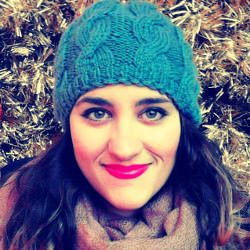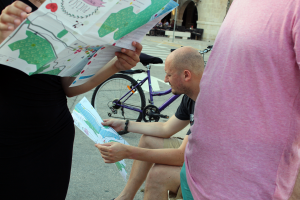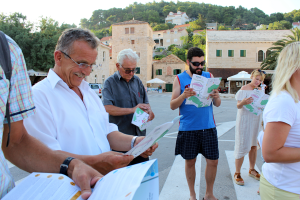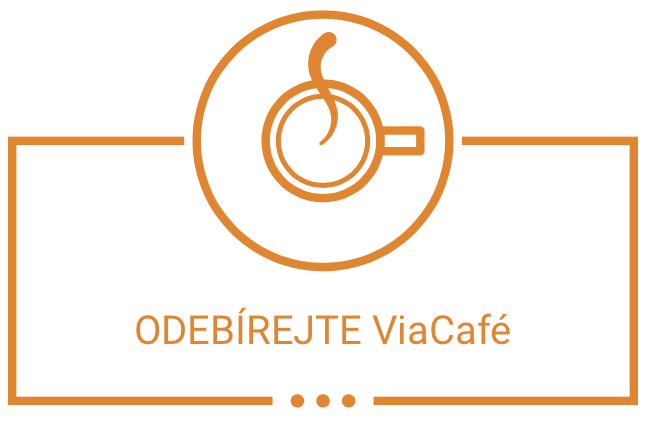Dijana is from Croatia. When she was a little girl, Dijana lost her father during the Croatian War of Independence. Although she and her mother and brother left their home in Pučišća and moved to Split, Dijana never forgot her hometown on the Croatian island of Brač. She had spent many childhood holidays at her grandparents’ house there and always felt the urge to give her community back what it had given her: happiness. After college she decided to move back to Pučišća. With the help of government funding and the ViabilityNet program, she has become a community leader there.
Author: Anna Batistová
Dijana, you were recently elected to the Pučišća local nemty council. Congratulations! How did that come about?
While I was working in my community, I saw so many things that were wrong and yet very simple to solve, but nobody was solving them. I ran a volunteer centre in my community and my colleagues and I decided to put together a list of independent candidates. We were not a political party so we needed at least 11 people on the list to be able to participate in the local elections. Even though I met some of the people on the list only a few days before the elections, all of them agreed that I should be the second candidate on the list. For me it was a satisfying moment when I realized that people recognize my work even though they don’t know me personally. Our campaign was completely positive. We didn´t comment on the negative things other parties did or on aspects that were wrong within the community. We only talked about the good things and about things that we could do in the future. I think that’s the reason we got so much support. As a new political movement on the scene, we got 3 out of 11 seats in the local council. Quite a success considering that the second biggest party got only 1 seat. It was surprising to all of us.
What is this new role of yours all about? What does your contribution to the local council entail?
My colleagues and I were elected at the end of May and in less than four months we have already managed to have three council meetings. Previously they had about five meetings over the entire year. We wanted to get started with all the smaller projects, we didn’t want to postpone anything. In this manner we are kind of “overachievers”. One of the biggest problems we wanted to solve was that there are so many open calls from the European Union, from national foundations, from many diverse sources and our local municipality almost never applied to any of them. We missed so many opportunities! This is what we really wanted to change. We started with the small group of people (“the action group” that Dijana developed during the ViabilityNet program, editor´s note) to look for different open calls.
And here you are, writing your first project proposal as part of the local council. What is the aim of it?
It’s to develop the cinema program in our community. We are working on this project in cooperation with the festival of Mediterranean films. They have a program called Kino Mediterranean and they are trying to bring back to life all the old cinemas on the island. Our old cinema was opened 60 years ago but it hasn’t been working regularly for the past 20 years. We have the entire facility but we don’t have the equipment. The people from the festival have already done some screenings in Pučišća, but they always had to bring their own equipment and that was very expensive for us. Now with this project we will have screenings over the whole year and not just five of them during the summer. This project is important to us because it is the first one we are doing with the local government, who is our political opponent.
Let’s go back to the beginning. Do you remember the very first moment you decided you wanted to do something for your community?
I was born on the island of Brač and I lived in my community as a child, but then my father died during the war and we moved to the city of Split. Going to the island was always kind of a vacation to me. I spent a lot of time there with my grandparents. The island was a getaway, not just a vacation, but a place of peace and rest. I always had this urge to give back to my community what it gave me and that was happiness. All my life I felt that I owed something to my community. During college, I wrote many projects and developed many activities. And then at the end of my studies, there was an opportunity to develop one project for my community. Of course, I did it and we got funding from the government for two projects and we were able to employ two people: one of them was me. That’s how four years ago, when I was 24, I moved back to Pučišća and started living in my community permanently. I opened the volunteer centre, which became the first volunteer centre ever on any of the Croatian islands. And we opened the youth centre, too.
Can you tell us more about the activities of the two centres you opened in Pučišća?
The volunteer centre was basically promoting voluntarism on the island. We organized different volunteer activities and helped local NGOs follow the law on volunteering because it was all mixed up and nobody was doing it the way they should. I had 12 activities that I was supposed to do during one year and I did 76 because the need in the community was so big. They were all asking me for help and I was happy to do it.
The youth centre was basically providing activities for children and youth – for example film screenings on different parts of the island, workshops on comics and film-making, different lectures and so on.
Within one year I really got to know all the people in my community and on the entire island and I finally realized all the missed opportunities. And the offices of both centres were in the municipal building of Pučišća, which is how I got into contact with the local government.
When you applied for the ViabilityNet program, your aim was to develop an action group for social, cultural and tourism development of Pučišća. If you could look back and compare, how did the situation there look when you started the project and how did it look afterwards?
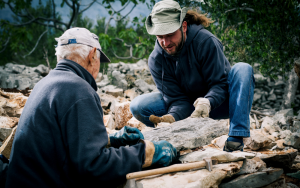
As you just said, in the beginning of the project, people from your community were not interested in participating in community development. But then we saw photos of community gardening, building a stone lime kiln, clean up events and even a carnival. It seems like the attitude has shifted…
Usually I start by doing, showing by example. In the beginning, I had to do something alone. Some projects from the ViabilityNet grant only included me and one or two other people – for example the community gardening project. There were only three of us gardening, but after that people really came up to me and said: “You really did an excellent job. I am so sorry I wasn’t part of it.” And indeed, later they became part of it. We had lengthy discussions about what could be done, we discussed examples of success from other communities and we also had some lectures. These were some of the tools I used to implement the idea that change is possible.
If you were to choose just one thing, what do you consider the most important change that you have achieved in Pučišća?
My favourite project was developing the map of Pučišća. My village was not very tourism-oriented. We didn’t have a map, we didn’t have a functioning tourist organization, nothing. So, we met and wrote descriptions for the map and designed it. The map is based on Use-it principles: it’s written by locals for tourists who want to experience something that is important to local people. Our local government and other people in the community expected us to write down a list of all the churches and such but we didn’t want to do that. For example, one place on our map is an old lady who makes the best cakes in the village – that was the type of map we wanted to create. We did it our way and I think it looks wonderful. We published about 400 copies and people from the village took all of them so there weren’t any left for the tourists. This year we published an updated version of the map and we are doing it for other villages, too. It was a great tool for people to get together and write. About 11 people worked on the writing of the map and translating into our local language and it was really a great moment for the community.
Besides the map there is also a whole new website – https://bestofbrac.com – where you write articles for tourists. When I read it it seemed that Brač is a perfect place to go for a holiday! What kind of project is this?
Best of Brač is a company where I work. It is a destination management company which we opened less than two years ago because we wanted to show different sides of the island of Brač – gastronomy, culture of the island and so on. One of the activities we do as a company is that we help organize events, for example cycling and running competitions. About 300 people come to Brač for these events. And since I write all the articles, one of my favourite things to do is to check Google analytics to see how many people have visited our website. They are from all over the world so I am happy.
Over the last four years you have been working for your community, have you somehow shifted or even changed in a personal way?
The biggest change would be from being an introvert to not being an introvert. I am usually the one who is always silent and when I am in group, I don’t speak very much. I am always behind the scene and I don’t like to be out in front. I have seen that people like me don’t want to take on the role of leader and this is what ViabilityNet helped me with. The program showed me that there are various kinds of leaders. It was comforting to realize that a leader doesn´t necessarily have to be an extrovert, the loudest one of the group. I was also always scared to approach government officials, for example the mayor, but now I am not. ViabilityNet taught me that I am just as valuable as the people who I am approaching.
Given the path you took, how important was the ViabilityNet program to you?
I have participated in more than 30 projects during my life and this was the crucial one and at the same time my favourite one. I learned so much in such a brief period. Unlike other projects, it gave me resources to develop some crazy ideas, which I couldn’t get funding for otherwise. For example, it helped me with the construction of a vapnenica, a traditional stone lime kiln, which is something that hadn’t been done in more than 50 years. I enjoyed the flexibility of the program, too. And all the traveling and all the things I saw and learned, it really inspired me. I especially remember the anthropological group that visited us in Hungary. I have a degree in anthropology but I never worked as an anthropologist. In Croatia, this is a profession in which you cannot find a job. With ViabilityNet, I worked as an anthropologist in my community and the program showed me people having their own companies working as anthropologists. That was so important to me on a very personal level. What’s more, I am currently preparing a dissertation about applied anthropology inspired by those examples and will most definitely use my ViabilityNet experience in the writing of it!
And what would your message to all potential participants of the ViabilityNet program be?
To write everything down! There is so much information and interesting studies that are discussed during the program. I still have my notebook from the ViabilityNet program and I look at it very often. There are so many inspiring stories of people who were participating and people who we visited. It’s just a huge inspiration and source of many solutions to various kinds of problems. Whenever I have some issue, I know there is always someone from the group who knows the solution.
Dijana Šabić (1989) is a Croatian activist, councilwoman in Pučišća and project manager at Best of Brač. She has a master’s degree in sociology, anthropology and economics.

